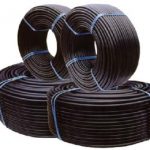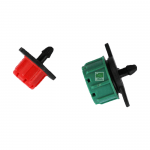ORCHARDS DRIP IRRIGATION FOR SALE IN KENYA

Orchard drip irrigation system is the most efficient way to irrigate orchards since it can save water and nutrients by allowing water to drip slowly to the roots of the fruits plants, either above the soil surface or buried below the surface. Therefore, it is a more so efficient and effective method compared to overhead sprinklers and surface irrigation. Besides water efficiency, drip irrigation also reduces the risk of plant diseases that thrive in wet conditions.
Drip irrigation in Kenya is commonly used in an orchard because it minimizes the cost of production due to the larger spacing between the emitters and laterals. This also has some added advantages to the farmer in that it simplifies the irrigation procedure, thus minimizing distribution and evaporation losses. In addition, the system can be automated with a time clock and moisture sensors, and automated valves, thus maintaining optimal soil moisture with minimum labor.
Special features of the orchards plants that make drip irrigation possible.
Orchard drip irrigation is considered one of the best ways of irrigation an orchard because some of the orchards plants have various characteristics that are delicate when exposed to other irrigation methods.
- The orchard’s plants are planted with a more considerable spacing difference between the rows and plants. This larger spacing is very easy to accommodate the drip irrigation method since They can efficiently distribute water per the individual plants.
- Most orchards plants are adapted to any topography, be it flat land, rugged landscape, or even sloping lands; thus, drip irrigation is the best for this kind of plant.
- All orchard plants require even water distribution at all times. Therefore, drip irrigation now becomes the only remedy for water solutions on such a farm.
- The majority of these orchard plants have got a high rate of water absorption rate. Therefore, they can only solve this case by applying the drip method of irrigation.
- These farms contain plants of single varieties that make it possible to be irrigated by a drip system.
Orchard plants can be irrigated using the drip irrigation method.
An orchard is a broad field spectrum that combines so many types and varieties of crops and plants. Some of these crops cannot survive under drip irrigation due to their unique features.
Example of orchard plants that can be watered by applying drip irrigation methods includes:
Vegetables
Cabbage,greenchillies,beetroots,brocoli,capsicum,carrots,cauliflower,cucumber,pumpkin,onion,peas,sweetpotatoe,tomato,etc.
Plantations
Areca nut, cashew nut, cocoa, coconut, oil palm, tea, coffee, mushroom, tomato tree, avocado, etc.
Fruits
Apple, banana, blueberry, chestnut, guava, mangoes, jackfruit, fig, papaya, passion fruit, pineapple, strawberry, water melon, almond tree, sweet oranges.
Factors to consider when designing irrigation system for an orchard.
When designing the drip system for avocado trees the following should be considered
-
Sustainability rate
The Ideal system should be capable of delivering water to a limited area under each tree when young to reduce water wastage.
-
Wetted diameter
System should be capable of increasing the wetted area to take into account tree growth and larger canopy area at orchard maturity. Sufficient pressure and pipe delivery must be catered for as the system has to expand.
-
Durability and flexibility
The drip system should not be prone to blockages.
-
High water delivery rate
The system should be capable of delivering more than 40 to 70 liters of water per hour per emitter .It should be designed in such a way that the cycle time between irrigations does not have to exceed one week. On well-drained soils, stress conditions can develop rapidly especially during periods of hot weather.
-
When to irrigate
The most efficient way to water is to apply water when it begins to show signs of stress from lack of water .These signs of water stress includes footprints or tire tracks that remain in the grass long after being made, many leaf blades folded in half, premature fruit drop and flaccid fruits on trees. The system should be designed in such a way that different blocks on different soil types, are capable of being irrigated as separate entities. This is important as water requirements can differ.
-
Efficiency of water application
An efficient watering does not saturate the soil, and does not allow water to run off. Therefore it is advisable to avoid extremes in watering frequency and amount. If you apply too much water, it runs off and is wasted. On the other hand, light frequent watering is inefficient and encourages shallow/restricted root systems.
Components of orchard drip irrigation system.
Orchards drip irrigation design components comprises of the following sections
Control head or pumping units
This comprises of valves, discharge, and pressure meters. It provides a means for Control and regulation of discharges, and pressures, including non-return valves and air vents. It also has an automation and control equipment, filters and dissolved fertilizer applicators.
The Main pipe

This is generally a rigid pipeline made from HDPE, asbestos cement or concrete. The main pipe is almost always buried and conveys water from the source to the main control points in the field.
The Sub-main pipe
This is a multi-valve pipe distributing irrigation water to the various sub-units within a unit. It is made up of rigid black polyethylene pipe which in most cases laid on the ground surface, with a diameter ranging between 32mm to 90mm “1.25” t” 3.5″),at a pressure of 4 atm. When designing the sub main line it is good to consider several factors which include topography of the land, field geometry, water supply and the uniformity required.
The Manifold pipe
This is either a flexible (soft) or rigid pipe of high density polyethylene type, generally 20 to 75 mm diameter, which distributes water between the laterals belonging to a single sub-unit. The manifold and its lateral are designed and operated as a single unified system which is controlled by a single valve.
Lateral or Drip line pipe
This is basically a flexible (soft) polyethylene or PVC pipe buried or laid on the ground surface and which carries emitters or drippers.. Its diameter ranges from to 0.5 to 1- inch and the pressure rating about 4 atmospheres.
The Emitters or drippers

An emitter is a device or system element which makes the drip irrigation possible by providing irrigation water at low flows and atmospheric pressure. In Avocado drip irrigation design, the most suitable emitters used are selected based on the following factors such as low in cost, uniform in structure and operation ,simple to manufacture, and install, should be able to maintain low problematic at standard operating pressure of between 3 to 30 m, and should be able to produce a constant low-rate water supply at varying line pressure change.
Other design components of avocado button drip irrigation include:
Water meter, reduced pressure backflow device, main valve, valve, flow meter gauges, air –vacuum relief valves, injecting equipment and filters.
Design layout of the orchard drip irrigation system.
To start the installation process, the following should be in place.
- Tape measure, hose puncher to attach emitters to the pipes goof plugs to plug up any unwanted punch holes, metal stakes and zinc ties to secure the drip lines on their location.
- Connect the water source to the main line delivery pipe using a water valve. Connect the two with a backflow preventer valve to stop contaminated water from leaking back into the initial water source.
- Once the water source is connected to the main water distribution line, lay the laterals and delivery lines in accordance with the layout of your farm. Roll the tubing out around the garden beds, laying the line flush.
- Once the mainline and laterals is in place, use a punch tool to make a hole in the lateral line wherever an emitter goes. Position your emitters so they are close to the root zone of each plant. To punch the holes, use boiling water or a hair dryer to heat the tube, which makes it softer to make holes. Once you have the tubing laid out and your emitter holes punched, secure the tubing into the ground with tubing stakes.
- Once the system is completely installed, it needs to be tested by allowing water to flow in to the system.
Design layout of the orchards drip irrigation system continuation
- Before allowing the water in to the system, ensure that all the valves are open. After main, sub mains and laterals are flushed completely close the flushed completely close the flush valve and end caps.
- After closing of the valves and caps check the pressure at pressure gages and ensure that the pressure at the selected points is as per the design pressure.
- It is also required to check the working of filters, air release valves and the fertigation unit. Once it is ensured that all the component is in good working conditions, then the operation should start.
- Test the efficiency of water flow by turn on the water and allow it to run freely for a few minutes to flush out any dirt or debris. Once you see the system runs properly, close the tubing with an end cap.
Maintenance of orchards drip irrigation system.
For the water distribution in an orchard to perform effectively, proper maintenance should be done in various sections of the systems. This will also reduce the cost of production in terms of inputs and labor requirements to a farmer.
- Emitters used should be able to match with the topographical status of the orchard farm. This should be checked regularly.
- Orchards drip irrigation requires much spacing thus thinning should be done regularly in order to determine the quality of irrigation.
- The distribution of the trees and crops should be in uniform state for efficient water use.
- In an orchards with high drip irrigation demands alternative pipes should be factored.
- When installing the orchard drip irrigation system, sub main line specifications should be considered.
- This is to ensure maximum efficiency of drip irrigation systems. It also helps to protect the drip lines and drippers from early degradation by weather and chemicals.
Advantages of orchard drip irrigation system.
Orchards drip irrigation system has got various benefits to the farmer as follows.
- Water is used and distributed at the optimum level.
- Improves soil conditions.
- Enhances food security to the farmer.
- Allows reuse of waste water.
- Fertilizer or nutrient loss is minimized during application..
- Weeds effect are minimized since there is no water available for them
- Drip irrigation enables the farmer to achieve maximum crop yield.
- Fertilizers can be used with high efficiency.
- Drip irrigation ensures minimum operating cost
- There is no soil erosion as water is applied directly to plant roots.
- Soil infiltration capacity is increased.
- Fertilizers and ground water is not mixed.
- improved seed germination is highly achieved.
- We can use recycled water safely.
- We can irrigate water in irregular shaped lands.
- In this method of irrigation, energy cost is greatly reduced since it is operated in lower pressure.
Disadvantages of orchard drip irrigation system
Being that drip irrigation system is a very important tool to a farmer, it also possesses some few disadvantages.
- Orchard drip irrigation is very expensive due to high initial cost to poor farmers thus not suitable for struggling farmers.
- Clogging of drippers and emitter is a common thing in all drip irrigation systems. It may thus discourage most farmers to invest on this drip system of irrigation.